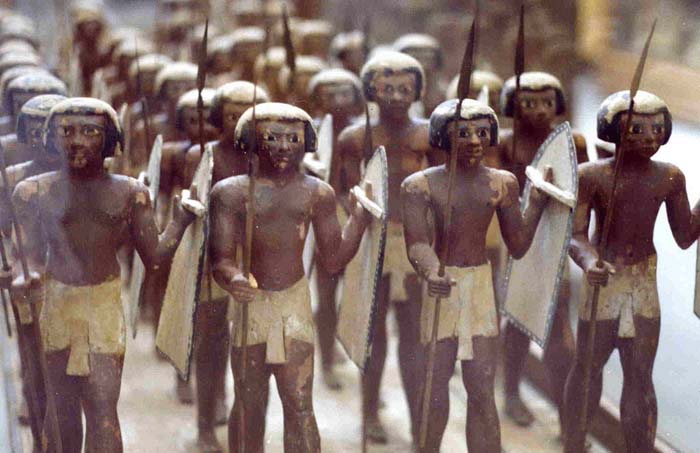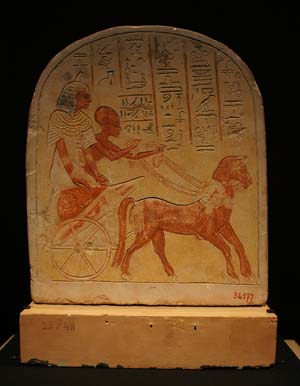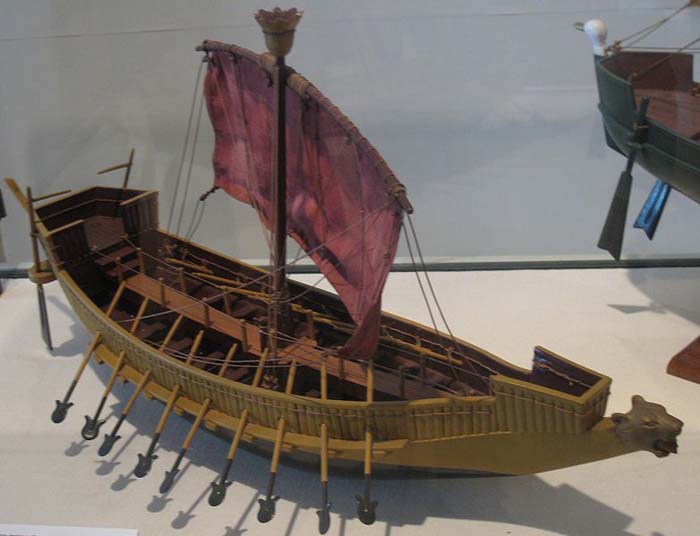Ancient Egypt Warfare
The ancient Egypt is considered to be one of the most peaceful of ancient civilizations -- so peaceful, in fact, that they did not have a proper army until the invasion of the Hyksos during their 15th Dynasty! Ancient Egypt and its people went from being very religious and peaceful to needing to keep their lands free of foreign hands.
Ancient Egypt was indeed ancient. Humans settled in Egypt during prehistoric times, and the first pharaoh came to power sometime in the 31st century B.C. Egypt continued to exist as an independent country until 332 BC when it was conquered by Alexander the Great.
During much of that time, Egypt was ruled by stable kingdoms, but there were periods of instability called Intermediate Periods. The Egyptian rulers or pharaohs were, for the most part, more concerned with keeping enemies out rather than with invading anybody.
The Old Kingdom (2686 BC -- 2181 BC)

© Jeff Dahl - Ancient Egypt
Ancient Egypt prospered during the time of the Old Kingdom, which enabled the pharaohs to put together a military. For much of ancient Egypt's history, the country faced four main threats:
- The Libyans who were to the South-West;
- The Nubians who lived South of Egypt;
- The Sinai and the Canaanites who hailed from the North-East;
- Internal strife caused by the rulers of the Nomes or provinces.
During the time of the Old Kingdom, the Nubians were the most dangerous threat, so the Egyptian military built forts along the Nile to keep them out. There was no professional army during this period, and the governors of the Nomes were expected to raise volunteer armies when they were needed. The armies would then all battle together under the pharaoh.
Most soldiers came from the lower classes, and the job had little prestige. Soldiers used many kinds of weapons including cudgels, daggers, spears, shields and maces. The most common weapon, however, was the bow and arrow. At this time, the Egyptians used a single-arched bow which was hard to draw.
The Egyptian navy first appeared during the latter days of the Old Kingdom. Back then, naval vessels were used largely to transport troops.
First Intermediate Period (2181 - 2055 BC)
The First Intermediate Period began sometime after the death of Pepi II, who had lived to be into his 90s, which meant that he had outlived his heirs. That caused problems with the succession, and the growing power of the provincial governors exacerbated matters.

© Udimu - Soldier Figurines from the 11th Dynasty
The result was a period of chaos during which the governors fought each other for power and a string of weak pharaohs proved unable to reign them in.
By the end of the First Intermediate Period, two dominant dynasties had emerged: the Heracleopolitan kings in Lower Egypt and the Theban kings in Upper Egypt. The last Theban king, Mentuhotep II, defeated the Heracleopolitans around 2033 BC and reunited Egypt into a single country. He thus became the first ruler of the Middle Kingdom.
The Middle Kingdom (2055 - 1650 BC)
Mentuhotep II ascended the throne of Thebes in 2055 BC. Twenty-two years later, he reunited Upper and Lower Egypt into a single kingdom. He led other military campaigns as far south as the Second Cataract in Nubia. It had become an independent state during the First Intermediate Period, and Mentuhotep II restored Egyptian control over it. He also conquered the Sinai region, which had left Egyptian control at the end of the Old Kingdom. His reign lasted for 51 years.
His son and successor, Mentuhotep continued consolidating Egypt under Theban control. He also built a series of forts in the eastern Delta region to protect Egypt from Asian attackers. His reign lasted only 12 years.
In the 12th dynasty (1991 - 1802 BC), pharaohs began maintaining standing armies. They were used for expeditions across the Sinai or up the Nile or to defend the realm from invaders.
Senusret III (1878 - 1839 BC) led a series of campaigns in Nubia. He often took to the field of battle himself, and he built many forts on the border of Egyptian conquests and unconquered Nubia. By his time, the regional governors had been stripped of much of their power.

© Justin Ennis - Senusret III
Second Intermediate Period (1650 - 1550 BC)
For much of this time, Egypt was under the control of the Hyksos, a Canaanite tribe from the north-east. They sacked Memphis which was then the capital and seized control of the country. Many Egyptians fled to Thebes where they eventually organized a resistance.
The Hyksos had a major influence on the Egyptian military because of their advanced technology. They used chariots and composite bows, and the Egyptian soldiers soon adopted these for their own use. The composite bow was a superior weapon to the single-arched bow, for it provided greater accuracy and could kill from a greater distance.
The ancient Egyptian army organization developed a lot during the battles against the Hyksos. It gained a more definite hierarchy with the Pharaoh serving as the commander-in chief. At the bottom were common soldiers, with the lowest-ranking commander being in charge of 50 men.
Above that commander was one who was responsible for 250 men. He reported to a captain who then reported to a troop commander. The garrison troops overseer ran an entire garrison. He commanded the troop commanders and their men and reported to an overseer who commanded all of the forts. The overseer reported to a lieutenant commander who reported to a general. The generals reported to the Pharaoh.
The New Kingdom (1550 - 1069 BC)

© Tjflex2 - Relief of a Chariot
The first Egyptian chariots were introduced during the beginning of the 18th Dynasty at the start of the New Kingdom. The Egyptians gradually improved their chariots, making them faster and lighter.
Egyptian war chariots typically carried two people: the driver who controlled the chariot and a warrior. The latter typically used a bow and arrows. When he ran out of arrows, he would use a short spear.
Charioteers sometimes wore scale armor, but many carried shields or wore leather bands across their chests. Charioteers generally only wore armor that protected their upper bodies, for the chariots themselves protected their lower bodies. Unlike most other soldiers, charioteers generally came from the upper class.
The scale armor was first seen during the 19th Dynasty (1292 - 1189 BC). Another innovation seen in the New Kingdom was the khopesh, a type of sword. It was somewhat sickle-shaped and had evolved from battle axes.
By the time of the New Kingdom, the Egyptian military had three main branches: infantry, navy and chariotry.

© Deror avi - Warship Model (based on an Egyptian ship from the reign of Ramses III)
Third Intermediate Period (1069 - 664 BC)
The Third Intermediate Period began with the death of Ramses XI. Towards the end, Assyria arose as the feared enemy power. Assyrians were noted for their use of iron weaponry. Forging iron called for using charcoal which, in turn, called for using lumber. Assyria had far more trees than did Egypt, so they had the advantage in this matter. That proved to be a major problem when Assyria invaded Egypt in 670 BC.
Late Period (664 - 332 BC)
The major innovations seen during the Late Period were mounted troops (cavalry) and weapons made of iron.
The phrase "late period" refers to the fact that this was the last period in which Egypt was ruled by native Egyptians. The Ptolemaic dynasty, which ruled from 305 BC to 31 BC, had originally come Macedonia. The Romans then seized control of Egypt in 31 BC
